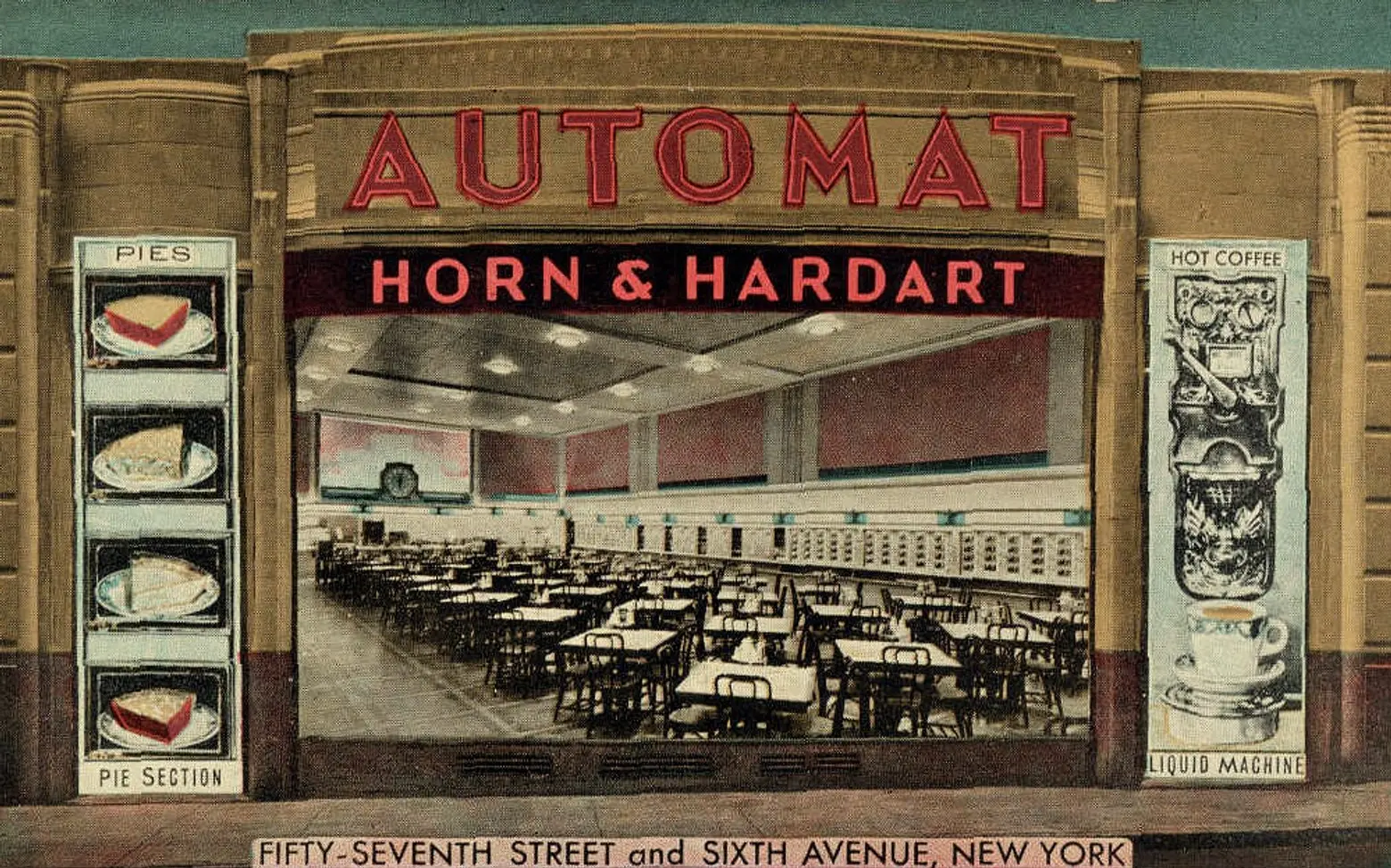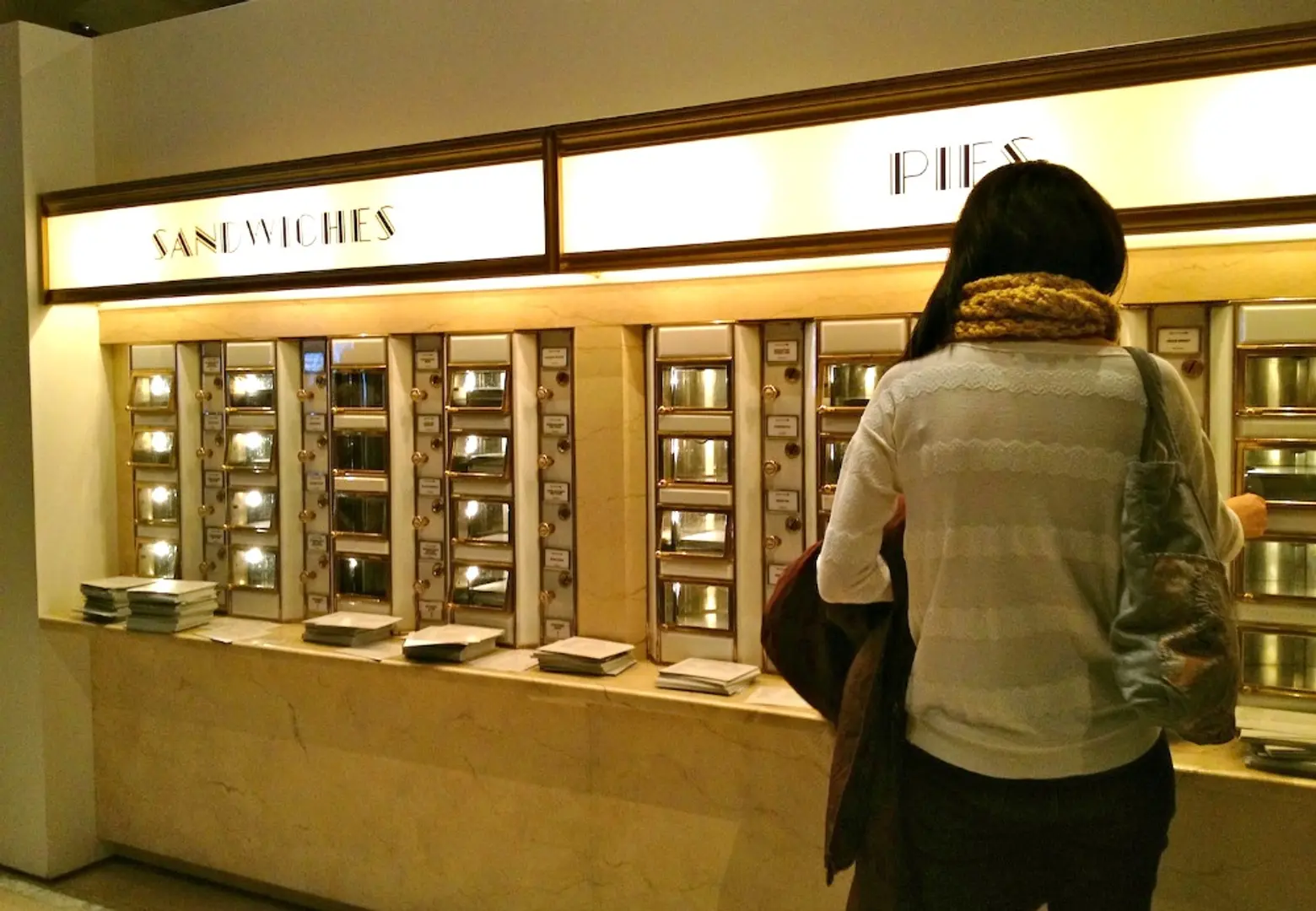Horn & Hardart Automats: Redefining lunchtime, dining on a dime

Automat by Berenice Abbott, 1936
In the 1930s, ‘40s, and ‘50s Automats were a New York City dining staple for a hard-working lunch crowd, a modernist icon for a boundless machine-age future. At their height there were over three dozen in the city, serving 800,000 people a day. And nearly everyone who actually experienced Automats in their heyday says the same thing: They never forgot the thrill of being a kid at the Automat.
Created by Joseph Horn and Frank Hardart in Philadelphia in 1902, coin-operated Automats were lovingly-designed Art Deco temples to modern efficiency. Sleek steel and glass vending machine grids displayed sandwiches and main dishes as well as desserts and sides, each in their own little boxes, square and even, clean and well-lit. You put a coin in the slot, opened the door and removed your food—which was reportedly quite good, as the founders took terrific pride in their craft.
 Horn & Hardart/Lumitone Photography, New York via Wikimedia Commons
Horn & Hardart/Lumitone Photography, New York via Wikimedia Commons
For some, it was the idea of choice, and the satisfaction of seeing exactly what you were about to select; the interactive aspect of putting a coin in the slot and unlocking a world of mac-and-cheese goodness; the mysterious disembodied hands whisking a hot meal into a tiny cubby from behind closed doors. It was like a magic show–with food.
 A Horn & Hardart automat, via NYPL
A Horn & Hardart automat, via NYPL
Horn and Hardart first encountered the idea in Germany, where the vending machines were being designed by an engineer named Max Sielaff. Though they were already in wide use in Europe, America had been a tough sell. Horn and Hardart had a reputation for innovation. To them, bringing the concept to NYC seemed like a perfect fit. The first New York City Automat opened in Times Square in 1912.
Considered by many to be the precursor of fast food joints, Automats became a regular spot for journalists, actors and anyone who hadn’t the time to linger over a meal. You could see what you were getting. You didn’t have to tip. And their gee-whiz interactivity made them a huge hit with youngsters. The food was fresh, cheap and fast. The mac and cheese was an instant classic. And the coffee was reputed to be the best in town. Freshly brewed every 20 minutes, it cost only a nickel a cup.
 Horn & Hardart Automat on 57th Street. Photo: Horn & Hardart/Lumitone Photography, New York via Wikimedia Commons
Horn & Hardart Automat on 57th Street. Photo: Horn & Hardart/Lumitone Photography, New York via Wikimedia Commons
Another memorable aspect of the Automats: The surroundings resembled a Parisian bistro more than a fast food joint. Marble countertops and floors were accented by stained glass and chrome; coffee poured from silver dolphin spouts sourced in Italy. The famous Automat cashiers were real pros, their lightning-fast change dispensing technique learned from so many hours on the job.
In addition to being endless fun for youngsters, the concept met a real need at the time, and, in their way, revolutionized the regular-guy dining industry. Prohibition had shuttered the saloons with their traditional free lunches. With no wait staff to tip and with most items priced at a nickel or a dime, Automats appealed to working-class and thrifty diners. And though the food was thoughtfully prepared, unlike the elitist dining rooms that were the norm on the American culinary scene, Automats were frill-free and democratic. Immortalized in numerous movies–such as “That Touch of Mink” (1962) starring Doris Day and Cary Grant–and popular songs, the Automat symbolized everyman’s–and woman’s–New York City.
Said the technocrat,
To the Plutocrat
To the autocrat,
And the Democrat—
Let’s all go eat at the Automat! —New York Evening Sun, 1933
Due to the realities of cheap labor and expensive real estate, the population shift from the city to the suburbs and the availability of fast food and frozen dinners, Automats were eventually reduced to a tourist novelty; the last one, at 200 East 42nd Street, closed in 1991. This early version of fast food was finally replaced by it altogether. Horn & Hardart even purchased Burger King, Arby’s and Bojangles franchises.
 At the New York Public Library’s 2013 Lunch Hour NYC exhibition, vintage Automat-style glass doors dispensed recipe cards for making Horn & Hardart’s signature dishes. Photo: Tales of a Madcap Heiress
At the New York Public Library’s 2013 Lunch Hour NYC exhibition, vintage Automat-style glass doors dispensed recipe cards for making Horn & Hardart’s signature dishes. Photo: Tales of a Madcap Heiress
In addition to living on in fond memories, bits of the original Automats have been preserved. The Smithsonian’s National Museum of American History includes a section of the original Horn & Hardart Philadelphia Automat. The New York Public Library featured part of an Automat machine in its 2013 exhibition Lunch Hour NYC; Automat-style glass doors dispensed recipe cards for making Horn & Hardart’s signature dishes.
 Bamn! Automat-esque snack spot in the East Village, 2006-2009. Photo: Alex Eylar via flickr
Bamn! Automat-esque snack spot in the East Village, 2006-2009. Photo: Alex Eylar via flickr
In more recent times, Bamn! an “Automat”-style eatery on St. Mark’s Place in the East Village had a brief run; retro reminiscence and the obsession with shiny things in little boxes that characterizes the Japanese pop aesthetic met in a neon pink foodiverse of gleaming steel and glass mini-boxes. Their motto: “Satisfaction is automatic!” Though Bamn! channeled a bit of the Automat in its heyday, the establishment’s tenancy was short-lived, closing in 2009.
 FEBO automatiek in the Netherlands. Image: cc
FEBO automatiek in the Netherlands. Image: cc
In the early–and economically uncertain–days of the 21st century, are we ready to embrace a new version of the Automat? In the Netherlands, a company called FEBO has been doing a brisk business since the 1940s, operating automatiek food dispensaries in Dutch cities, serving late-night revelers and quick-lunchers from a selection of freshly-prepared local versions of burgers, croquettes and french fries.
 Japanese shikkenko “robot restaurant.” Image courtesy of Freckles & Fluff.
Japanese shikkenko “robot restaurant.” Image courtesy of Freckles & Fluff.
In Japan, where vending machines hold particular sway over consumers–coin-operated machines dispense everything from live lobsters and pet beetles for children to undergarments and toilet paper–Shokkenki “robot restaurants” sell simple noodle dishes, gyoza and other staples around the clock from a panel of cubbies similar to those in the Automats. A recent Harpers article describes them as “a distinctive mix of working-class luxury, respectful indifference, and all-hours accessibility,” making the point that we already use ATMs instead of bank tellers, automated check-outs in some grocery stores and automated ticketing in airports; restaurant chains like Chili’s and Applebees have even introduced touchscreen tabletop ordering systems.
 Original Automat machine (l), silver coffee spigot (r) available for sale from theautomat.com
Original Automat machine (l), silver coffee spigot (r) available for sale from theautomat.com
A taste of history
- The book, “The Automat: The History, Recipes, and Allure of Horn & Hardart’s Masterpiece,” tells of the history of automats and includes many of the original and beloved Horn & Hardart recipes.
- You can actually own your own automat vending machine; antique relics collector Steve Stollman of Ellenville, N.Y. sells original, restored and updated machines at theautomat.com.
- Buy Horn & Hardart coffee.
Hidden memories
- The first Horn & Hardart Automat in NYC was at 1557 Broadway. Though that location is currently occupied by a tourist memorabilia store, if you look up at the ceiling you can still see remnants of the restaurant’s deco detailing; the original brass staircase and a plaster ram’s head remain as well (Gotham Lost & Found).
- The Art Deco building that remains at 2710-2714 Broadway at 104th Street (it is currently a Rite Aid), landmarked in 2007, was built specifically for the Horn & Hardart establishment.
Peek behind the windows at an automat: “That Touch of Mink” (1962) starring Doris Day and Cary Grant.
“Sadie McKee” (1934). A woman covets a stranger’s half-eaten slice of pie.
RELATED:
- See How Much Central Park Has Changed Since the ’80s in These Before-and-After Photos
- A 1924 Proposal Would Have Drained the Entire East River to Reduce Congestion
- The First Panda Ever in the U.S. Lived in a NYC Apartment
Lead Image: Horn & Hardart/Lumitone Photography, New York via Wikimedia Commons.
Interested in similar content?
Leave a reply
Your email address will not be published.











































My mom took me as a child, it was treat…a very big one…the chocolate whipped cream cake was the stuff of fantasies
I have seen this summer new automats in Brazil, a place called Quickies. People love it to go to the place. https://youtu.be/4qmBk5WxqEg .
I also found a website of the provider of the new automats: http://www.braimex.com
Seems like just the kind of thing that would make a killing in Brooklyn. It’s the perfect hipster throwback.
Automat documentary coming in 2017! facebook.com/THEAUTOMATthemovie
There is not much I miss about Old New York, but the Automat is definitely one of them. Unfortunately, they were too labor intensive to compete in today’s market. Patrons rarely saw what went on behind those windows. In addition, the one thing that made people want to come to the Automat ( being able to linger over a cup of coffee for hours),aided in its downfall. People would actually bring their own lunch, sit at a table with just a 25 cent cup of coffee. Many people used the restaurants as their offices. ...
Read more